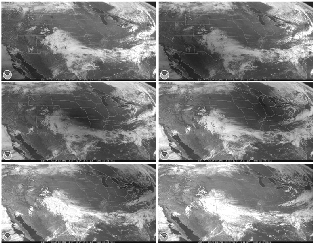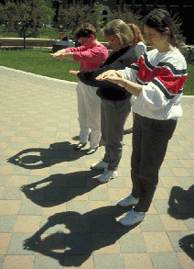
Ring of Fire

Ring of Fire
Tuesday, 10 May 1994
West Lafayette, IN, USA
|
A composite view of the progress of the annular eclipse over the Hovde Hall of Administration, Purdue University - my alma mater! Click on the picture to see it big. |
An eclipse in my own backyard! I didn't care that it was only annular - I wasn't going to miss this one for
anything! Wait a minute, though - did I say annular? What's that? Well, as usual, I'm going to have to digress
a little and give you some explanation.
An annular solar eclipse happens when, as usual, the moon goes in between the Earth and the Sun, and casts its
shadow on the surface of the Earth. But this time, the moon looks smaller to us than the sun does, and so, it can't
cover all of the sun's disk. This can happen because (a) the moon is farther away from Earth than usual, (b) the
sun is closer to the Earth than usual, or (c) a combination of these two things. The upshot is that even at mid-eclipse,
there's not going to be enough moon to cover the sun, and you're still going to see a bright ring of sun around
that smaller black moon. The word "annular" is derived from the Latin word for "ring" (Or,
if you don't like that, do you remember your high school Spanish, where the word for "ring" is "anillo"?),
so once again, there is some sense to be made of the way we English-speakers have stolen, er, invented our vocabulary.
I would never travel around the world to see an annular eclipse; it's just not cool like a total eclipse is. You
get some darkening of the sky, and there's some of the eerie light patterns that happen during a total, but it's
basically a huge letdown. Once you've seen a total eclipse, you understand that those things are just the build-up
for the real show yet to come, and in an annular eclipse, you don't get the show. It's like you make yourself a
big, juicy cheeseburger, but then somebody steals it out from under you before you can bite into it. I don't know
about you, but I want that cheeseburger! I've got a waistline to support.
Since the eclipse was going to go right over Indiana, the only concern we had was whether the weather would cooperate.
All the forecasts looked good, and, even though I was prepared to drive a couple hundred miles if I had to, there
turned out not to be any need. The morning of the eclipse was absolutely perfect, and it stayed that way all day.
If you look at the satellite view of the US (below), you'll see that a huge high-pressure area dominated over Indiana,
with not a cloud to be found. With that kind of weather, I could pretty much pick and choose my location. An eclipse,
even an annular one, is a special thing, and deserves to be viewed from a somewhat special location. I could've
stayed at home in Indianapolis, but chose instead to head up to the campus of Purdue University in West Lafayette.
I had graduated from college there almost exactly ten years earlier, and had only been back to the area once or
twice since then. It would be a great chance to see my old school, and there would be a lot of other scientific-type
people there to watch it with. So, that's where I went.

Quite a few people were there, as it turned out, and I had to make sure I found a suitable spot for what I wanted
to do. I'd seen multiple exposures of eclipses, where a lot of pictures are taken on one frame of film so you get
a kind of time-lapse effect, and I wanted to try one of these. This was pretty tricky, for a couple of reasons.
First, you have to know where the sun is going to be in the sky all through the eclipse, from beginning to end.
You can't move your camera during the eclipse, or you'll ruin the continuity of the sun's path across your film.
That means that if you have your camera in the wrong spot, you might find the sun wandering right out of the field
of view toward the end of the eclipse! You need to know how far the sun's going to move, what the apparent field
width of the lens you're using is, and the point in the sky the sun will be at when the eclipse is over. Then,
of course, you have to use the right exposure, make sure nobody messes with your camera for the 3-4 hours the whole
process will take, and space your exposures exactly the right amount of time apart from each other. Otherwise,
the individual exposures won't be the same distance apart on the final picture, and the progress of the eclipse
won't look smooth and continuous. It's a lot of stuff to keep track of, and an annular eclipse is the best place
to practice it. (If it doesn't work, you haven't wasted a total eclipse on it!)
Of course, my picture wasn't totally (or even annularly [yuk yuk]) perfect, but I never claimed to be perfect!
The overall effect was there, and the final piece of film was actually very good for a first attempt at the technique.
I wanted a perfect portrait of this eclipse, though, so I succumbed to artistic license and brought my computer
into play for the first time in an astrophotograph.
Photoshop to the rescue! Normally, I would cringe at the mere thought of manipulating a scientific picture. That
just isn't done, because in any scientific experiment, purity and accuracy of data is the most critical thing you
can have if you want your results to be accepted. I rationalized my actions by realizing that this wasn't a scientific
experiment - it was just an artistic rendering of a beautiful celestial event. Nothing I was going to do with any
eclipse pictures I took would ever make one bit of difference to the scientific community, but they might just
be cool enough to convince people that what I was chasing around the world was really worth the effort. It's pretty
well universally acknowledged that you can never take an eclipse picture that looks anything like what the eye
sees during an eclipse, so what the heck? Why not apply a little artistic license to what I'd done, in order to
show something I thought was really beautiful? It's what I always liked to do with my photography anyway, and this
case was no different.
So began my attempts to recreate eclipses the way I saw them. I think the result from this eclipse is really good,
even though I allowed myself quite a bit of freedom in creating it. The view of the building is looking toward
the southwest, and the eclipse itself was really centered closer to the south. The size of the individual sun images
is pretty accurate, and I've done a lot of cleaning up of the sidewalk, the buildings, and the trees. Overall,
I'm very happy with the result, and think it's a good look at a pretty eclipse. By the way, the images were taken
five minutes apart, and there wasn't much manipulating of the image to be done in that area; my timing was pretty
good!
As far as the eclipse experience goes, this one was OK, even though the eclipse was just annular. There were a
lot of scientists there, being that Purdue is a very heavily science-oriented school, and some very elaborate setups
were within shouting distance of me. As always, there were a lot of people there who didn't know much about what
they were looking at. These people always show up for eclipses, and it's amazing how much they want to know about
them. If these people were in school, and the topic for today's lecture were eclipses, you'd find a lot of them
sleeping through it. (More about schools and eclipses later…) But there's something about the immediacy of the
event that draws people in and gets a hold on them that won't let go until they've satisfied their primeval need
to understand the environment they've found themselves in. This reaction is universal; it transcends age, culture,
and language, and is guaranteed to make you a hero if it's perceived that you know more about eclipses than the
others in the crowd.
This can be a bad thing; there are times during your eclipse experience that you wish everybody would just go away
and let you do your thing in peace. But people are very good about respecting your privacy if you tell them it's
what you need to do. My rule is no talking for the ten minutes before totality begins, and I've yet to see it be
broken by anyone. People are generally good.

A great way to occupy people at an eclipse - show them how to make all the little eclipses on the ground with their hands. It works!
© 1998 Dan McGlaun